A Few Notes on Shi’ism in Syria and the Emergence of a Pro-Asad Shi’i Militia, Liwa’ Abu’l Fadl al-‘Abbas (Liwa Abu al-Fadl al-‘Abbas)
May 21, 2013 5 Comments
 Liwa’ Abu al-Fadl al-‘Abbas “martyr” Karrar ‘Abd al-Amir Abu Asad: “We’re [all] Your ‘Abbas, O’ [Sayyida] Zaynab“
Liwa’ Abu al-Fadl al-‘Abbas “martyr” Karrar ‘Abd al-Amir Abu Asad: “We’re [all] Your ‘Abbas, O’ [Sayyida] Zaynab“
-By Christopher Anzalone (Institute of Islamic Studies, McGill University)
July 26, 2013: Read my article, “Zaynab’s Guardians: The Emergence of Shi’a Militias in Syria,” CTC Sentinel (July 2013) HERE.
_________________________________
UPDATED MAY 22
A few initial notes/observations about Shi’i historical presence in Syria and the emergence of a pro-Syrian government militia, Liwa’ Abu’l Fadl al-‘Abbas (Brigade of Abu’l Fadl al-‘Abbas/Abu al-Fadl al-‘Abbas; Liwa’ Abu al-Fadl al-Abbas) in Syria:
(1) It is clear that the Iranian government has an interest on the part of the Iranian government and its regional allies in expanding their sphere(s) of influence in the Middle East and North Africa and the wider world, particularly in Muslim-majority countries and among Muslim communities, Shi’i and Sunni. While recognizing this desire and organizational, economic, and military support from the Iranian government to allied groups in countries such as Iraq, Bahrain, Afghanistan, Pakistan, and Syria, it is important to also understand the goals of these local actors in accepting such support.
Iranian government missionary activity and the emergence of Qum as the premier location of Twelver Shi’i religious education following the expulsion of foreign students and intensification of Iraqi Ba’th targeting of the Shi’i religious leadership and political activists in the late 1970s has allowed the Iranian government to expand its influence to other parts of the Middle East and North Africa as well as to Western Europe, West Africa, Afghanistan, Pakistan, and Southeast Asia. It is important to recognize, however, that the Iranian government’s goals are not shared by all Twelver Shi’is and the claimed religious authority of ‘Ali Khamenei is not universally recognized. Critiques of the late Grand Ayatullah Ruhollah Khumayni’s conception of wilayat al-faqih emerged the very year of Iran’s Revolution and have continued to be written to the present day. The politics of Iranian government attempts to expand its sphere of influence and the local factors aiding and hindering such expansion are complex and should be considered in any analysis of Twelver Shi’i communities and political activism.
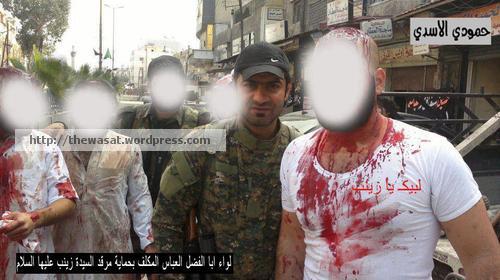 A photograph showing members of Liwa Abu’l Fadl al-‘Abbas with men who appear to have been performing one of the mourning rituals involving bloodletting during the Muharram mourning for Imam Husayn and his party. Not all Twelver Shi’is perform these rituals and Shi’i mujtahids have taken different positions on the permissibility of such rituals. Some have noted that none of the Twelve Imams, according to Shi’i tradition, performed such rituals, even in mourning for the Ahl al-Bayt. The rituals are particularly popular among segments of the South Asian, Iraqi, and Afghan Twelver Shi’i communities as well as followers of the Lebanese AMAL party and adherents (Shiraziyyin) to the Shirazi family of religious scholars, a member of whom founded Damascus’ Zaynabiyya seminary (hawza).
A photograph showing members of Liwa Abu’l Fadl al-‘Abbas with men who appear to have been performing one of the mourning rituals involving bloodletting during the Muharram mourning for Imam Husayn and his party. Not all Twelver Shi’is perform these rituals and Shi’i mujtahids have taken different positions on the permissibility of such rituals. Some have noted that none of the Twelve Imams, according to Shi’i tradition, performed such rituals, even in mourning for the Ahl al-Bayt. The rituals are particularly popular among segments of the South Asian, Iraqi, and Afghan Twelver Shi’i communities as well as followers of the Lebanese AMAL party and adherents (Shiraziyyin) to the Shirazi family of religious scholars, a member of whom founded Damascus’ Zaynabiyya seminary (hawza).
(2) Individual motivations for joining groups such as Liwa’ Abu’l Fadl al-‘Abbas may differ from the reasons the Iranian government or other state or powerful non/quasi-state actors have for supporting, organizing, or backing such groups. As Thomas Hegghammer has noted in his studies of the Muslim foreign fighter phenomenon, it is often very difficult to know exactly what the motivations were for specific individuals in becoming a “foreign fighter” since martyr biographies and accounts (martyrologies) released after their deaths often address/justify their decision and involvement in certain conflicts after the fact. Thus, they are not always reliable in understanding the actual motivations, outside of hagiographical narratives. There may (and in my opinion, likely are) personalized pietistic reasons (from the viewpoint of volunteers/recruits) at play in the decision of at least some of the individual Shi’is fighting under the Liwa’ Abu’l Fadl al-‘Abbas banner.
(3) It’s very important to note the deep-rooted reverence and love Twelver Shi’is have for Zaynab bint ‘Ali (Sayyida Zaynab), which, in my view, almost certainly has played a role in motivating at least some of the individuals who have traveled to Syria to, as they see it, defend her shrine and other important Shi’i shrines from destruction and desecration by some of the Syrian rebel groups.
Among her roles in Shi’i tradition, Zaynab is believed to have been one of the main reasons that the message of Husayn (Hussein, Hussain), the third Shi’i Imam, and thus Islam (according to the Shi’i point of view) was preserved even after his martyrdom at the hands of the Umayyad army of Yazid bin Mu’awiya. Her defiant speech in front of the Umayyad caliph himself is particularly heralded in the Shi’i tradition, particularly during the annual Muharram rituals of ‘Ashura, which commemorate the death of Imam Husayn and many of his small party (including his half brother, al-‘Abbas, whose honorific “Abu al-Fadl”/”father of” denotes his eldest son, Fadl.) His mother, Fatima bint Hizam al-Kilabiyya, was one of Imam ‘Ali ibn Talib’s wives and, according to Shi’i tradition, raised his sons by Fatima al-Zahra/Fatima bint Muhammad (the Prophet) as if they were her own. Al-‘Abbas, to Shi’is, is one of the heroes of Karbala, of whom portraits are painted and nasheeds and mourning recitations (latmiyas) recited during Muharram.
(3) The neighborhood around Sayyida Zaynab’s shrine in Damascus has long been a center for a community of Twelver Shi’is and popular devotees to the Ahl al-Bayt (the Prophet Muhammad’s family), both residential and scholastic (it’s been the site of a seminary, the Zaynabiyya, affiliated with the Shirazi family of scholars since the 1970s) as well as a center of Shi’i pilgrimage. Shi’i shrines, however, are also located in other areas of the city, such as that of Ruqaya bint ‘Husayn and Sukaina bint Husayn. These shrines have benefited from Iranian and Syrian governmental funding of restoration and expansion projects, but their importance as local holy sites and the sites of pilgrimage for the region’s Shi’is predates the advent of Iran’s “Islamic Republic.” These sites, however, have benefited from state patronage, which helped them become fully integrated as regular stops for Shi’i pilgrims from abroad (at least before the start of the uprising against Bashar al-Asad). Before the Syrian civil war, it and other important shrines in Damascus were regular sites of Shi’i pilgrimage, often as part of pilgrimage (ziyarat) trips that also visited Shi’i shrines in Iraq, Iran, and Saudi Arabia.
Iranian and Syrian state support and promotion of the Syrian Shi’i shrines in the 1980s was a part of both countries’ shared opposition to the Iraqi Ba’th government, which had imposed itself on the Shi’i shrines in Iraq, going as far as to appoint its own officials to “supervise” the sites in cities such as Najaf, Karbala, and Kufa. Similarly, the Zaynabiyya hawza benefited from an influx of seminary students, including a number of Afghan Hazara Shi’is, from neighboring Iraq expelled by Saddam in the second half of the 1970s.
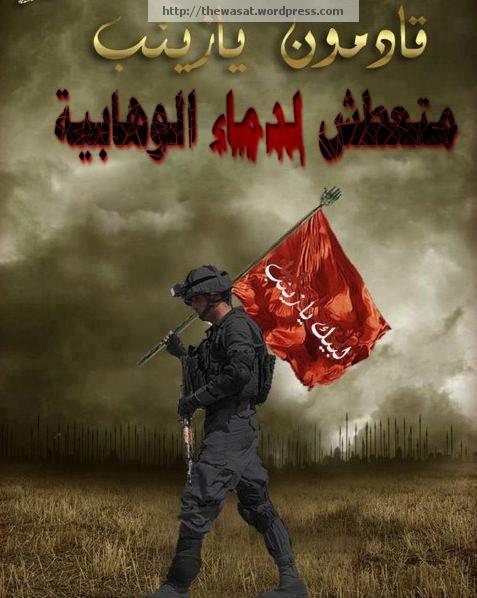 “We’re coming, O’ Zaynab…Thirsty for blood of the Wahhabis (al-wahhabiyya)…BANNER: We Heed Your Call/are at your service, O’ Zaynab,” denoting the Salafi foes that, according to the few available sources, Liwa’ Abu’l Fadl al-‘Abbas see themselves as fighting. Pro-Brigade Facebook pages and Internet postings often include photographs of killed “Wahhabis” and members, the sites claim, of puritanical Salafi rebel groups such as the Al-Qa’ida in the Land of the Two Rivers (Iraq)-connected Jabhat al-Nusra.
“We’re coming, O’ Zaynab…Thirsty for blood of the Wahhabis (al-wahhabiyya)…BANNER: We Heed Your Call/are at your service, O’ Zaynab,” denoting the Salafi foes that, according to the few available sources, Liwa’ Abu’l Fadl al-‘Abbas see themselves as fighting. Pro-Brigade Facebook pages and Internet postings often include photographs of killed “Wahhabis” and members, the sites claim, of puritanical Salafi rebel groups such as the Al-Qa’ida in the Land of the Two Rivers (Iraq)-connected Jabhat al-Nusra.
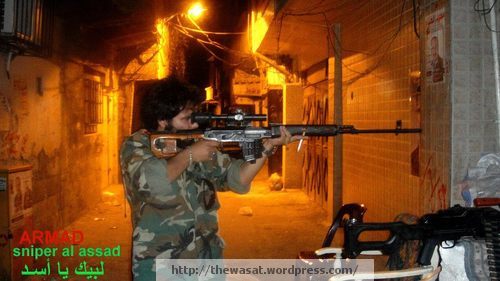 “We Heed Your Call/are at Your Service. O’ Asad”
“We Heed Your Call/are at Your Service. O’ Asad”
(4) Shi’i presence and shrines have existed in Syria, including in the north, from much earlier periods. Many of the Sunni rulers during the medieval period also had pro-‘Alid inclinations even if they themselves were not Shi’is.
(5) Syrian Sunnis (or some of them) also revere these figures. Salafis, due to their iconoclasm, oppose such shrines to varying degrees, the most extreme being actively targeting them for destruction.
(6) Some individual members and supporters are likely swayed by the claimed “axis of resistance” image heralded by the Iranian and Syrian governments as well as Hizbullah in Lebanon. According to this worldview, support for the besieged Syrian government is a way of resisting what is seen as U.S. hegemony in the region and the broader world.
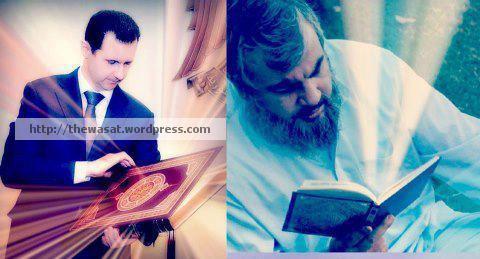 An Internet poster from a pro-Liwa’ Abu’l Fadl al-‘Abbas Facebook page showing Hizbullah’s secretary-general Hasan Nasrallah (right) and Syrian president Bashar al-Asad. The photograph of Nasrallah was taken after the 2006 Hizbullah-Israel war and has clearly been edited to show light emanating from the book (presumably the Qur’an). The same is true of the posed image of al-Asad. Both are shown by the designer as pious (thus, presumably, deserving of support).
An Internet poster from a pro-Liwa’ Abu’l Fadl al-‘Abbas Facebook page showing Hizbullah’s secretary-general Hasan Nasrallah (right) and Syrian president Bashar al-Asad. The photograph of Nasrallah was taken after the 2006 Hizbullah-Israel war and has clearly been edited to show light emanating from the book (presumably the Qur’an). The same is true of the posed image of al-Asad. Both are shown by the designer as pious (thus, presumably, deserving of support).
(7) The membership (and death) of a number of Iraqi Shi’is with Liwa’ Abu’l Fadl al-‘Abbas in Syria may have much to do with both the presence prior to the civil war of a large Iraqi expatriate community and contention in Iraq over who truly represents the legacy of the late grand mujtahid Muhammad Sadiq al-Sadr. Though one of his sons, Muqtada, leads what can be termed the “mainstream” Sadrist trend (Tayyar al-Sadr, al-Sadriyyun), which is composed of political, social, and paramilitary branches, he faces competitors from among those who studied or claimed to have studied (and excelled) with this father in the seminary. These include movements with varying degrees of messianist outlook such as that led by Mahmoud al-Hasani as well as individuals widely considered (or who consider themselves) mujtahids or grand mujtahids such as Kazim Ha’iri and Muhammad al-Ya’qubi.
 “Lion of the League [of the Righteous], Yahya Sarmud Muhammad al-Fayli,” pictured with the late Iraqi mujtahid Muhammad Sadiq al-Sadr (top left), Iran’s supreme leader (rahbar) ‘Ali Khamenei (top right), and ‘Asa’ib Ahl al-Haqq secretary-general Qays al-Khaz’ali/Qais Khazali (bottom right).
“Lion of the League [of the Righteous], Yahya Sarmud Muhammad al-Fayli,” pictured with the late Iraqi mujtahid Muhammad Sadiq al-Sadr (top left), Iran’s supreme leader (rahbar) ‘Ali Khamenei (top right), and ‘Asa’ib Ahl al-Haqq secretary-general Qays al-Khaz’ali/Qais Khazali (bottom right).
Others, such as Qays al-Khaz’ali (leader of the Iraqi Shi’i militia ‘Asa’ib Ahl al-Haqq/League of the Righteous, which is believed to enjoy Iranian state support), have donned the turban (‘amama) in a bid for religious scholarly legitimacy, despite often questionable education credentials. Though a number of the pro-Liwa’ Abu’l Fadl al-‘Abbas videos, many which appear to have been made and uploaded by “fans,” include photographs of Muqtada, it is possible that intra-Sadrist (using the term “Sadrist” to refer very broadly to a number of different movements claiming at least part of their legitimacy from the contested legacy of the late Muhammad Sadiq al-Sadr, who is considered a martyr at the hands of the Iraqi Ba’th, who assassinated him and two of his sons in February 1999) is also at play in the organizing of volunteers/recruits to fight in Syria.
 Qays al-Khaz’ali (seated to the right) in front of a picture of the man whose legacy he claims to be upholding, Grand Ayatullah Muhammad Sadiq al-Sadr.
Qays al-Khaz’ali (seated to the right) in front of a picture of the man whose legacy he claims to be upholding, Grand Ayatullah Muhammad Sadiq al-Sadr.
 “His eminence, the Shaykh Qays al-Khaz’ali, the general-secretary of the Islamic Movement of the Righteous [People of Truth].”
“His eminence, the Shaykh Qays al-Khaz’ali, the general-secretary of the Islamic Movement of the Righteous [People of Truth].”
 Liwa’ Abu al-Fadl al-‘Abbas martyr Karrar ‘Abd al-Amir Abu Asad (lower left) pictured with Iran’s supreme leader (rahbar) ‘Ali Khamenei (top), Hizbullah’s secretary-general Hasan Nasrallah (right), and ‘Asa’ib Ahl al-Haqq secretary-general Qays al-Khaz’ali (far right). There is also part of a verse (13) from the Qur’an, chapter (surah) al-Saff (The Ranks): “Help from God and victory is near.”
Liwa’ Abu al-Fadl al-‘Abbas martyr Karrar ‘Abd al-Amir Abu Asad (lower left) pictured with Iran’s supreme leader (rahbar) ‘Ali Khamenei (top), Hizbullah’s secretary-general Hasan Nasrallah (right), and ‘Asa’ib Ahl al-Haqq secretary-general Qays al-Khaz’ali (far right). There is also part of a verse (13) from the Qur’an, chapter (surah) al-Saff (The Ranks): “Help from God and victory is near.”
 Liwa’ Abu al-Fadl al-‘Abbas martyr Karrar ‘Abd al-Amir Abu Asad (lower left and right) pictured with the logo of ‘Asa’ib Ahl al-Haqq, which includes a part of a verse (13) from the Qur’an, chapter (surah) al-Kahf (The Cave), which reads: “Lo, they were young men who believed in their Lord and We [God] increased them in guidance! [We/God guided them].”
Liwa’ Abu al-Fadl al-‘Abbas martyr Karrar ‘Abd al-Amir Abu Asad (lower left and right) pictured with the logo of ‘Asa’ib Ahl al-Haqq, which includes a part of a verse (13) from the Qur’an, chapter (surah) al-Kahf (The Cave), which reads: “Lo, they were young men who believed in their Lord and We [God] increased them in guidance! [We/God guided them].”
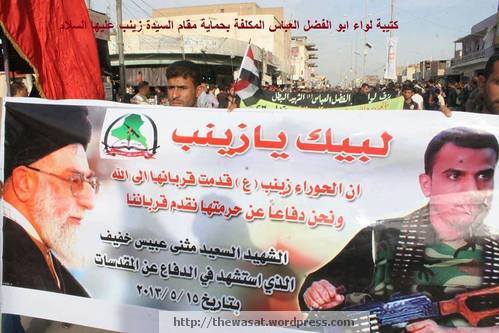 ‘Asa’ib Ahl al-Haqq “joyful martyr” (al-shahid al-sa’id) Muthanna ‘Ubays Khafif (right) pictured alongside ‘Ali Khamenei. Khafif is listed as having “self-sacrificed” (istishhad) in defense of the holy places (al-muqaddasat) on May 15, 2013.
‘Asa’ib Ahl al-Haqq “joyful martyr” (al-shahid al-sa’id) Muthanna ‘Ubays Khafif (right) pictured alongside ‘Ali Khamenei. Khafif is listed as having “self-sacrificed” (istishhad) in defense of the holy places (al-muqaddasat) on May 15, 2013.
____________________________________________
Given my research focus on martyrdom, the study of political Islam, and Shi’ism in the contemporary period, I hope to write more in both the near future on these topics as well as, probably, down the road for my dissertation.

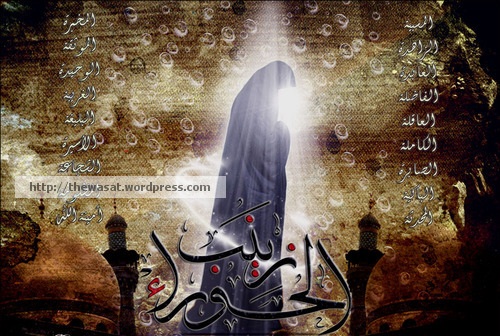
I am looking forward to more of your blogs concerning this (for me) complicated issue.
Pingback: Syria: Attack on Sayyida Zainab Provokes Sunni-Shiite Tensions in Lebanon, Iraq, Pakistan | Informed Comment
Pingback: Arab News Blog » Syria: Attack on Sayyida Zainab Provokes Sunni-Shiite Tensions in Lebanon, Iraq, Pakistan
Pingback: Syria: Attack on Sayyida Zainab Provokes Sunni-Shiite Tensions in Lebanon, Iraq, Pakistan | The Muslim Gazette
Pingback: Syria: Attack on Sayyida Zainab Provokes Sunni-Shiite Tensions in Lebanon, Iraq, Pakistan | Canadian Arab News